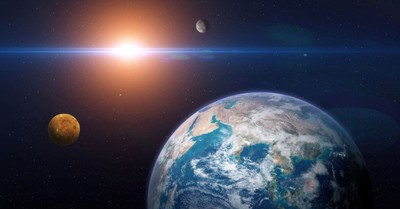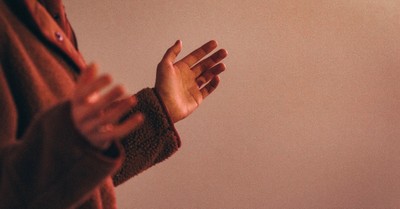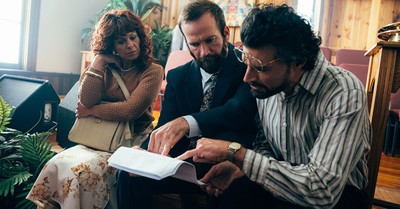A Look At The Moon - Part 1
- Jay Ryan
- Published Jul 09, 2004

We've all seen the familiar "Moon Face" designer motif. The Moon's "face" can be found adorning everything from wall calendars to home accessories. Items showing a Sun face, or combined Sun and Moon designer elements, have been very fashionable in recent years. One can hardly walk through "Bed, Bath and Beyond" without seeing dozens!
Such solar and lunar representations are popular with New Age types, such as devotees of astrology. But modern pagans should not have a monopoly on such celestial imagery. The tradition of showing the Sun and Moon with faces is very old. It is very common to see Medieval and Early Modern Christian works with woodcuts featuring the Sun and Moon with faces. Many of the The Biblical woodcuts of the great Albrecht Durer depict the Sun and Moon with faces. Even the frontispiece of the 1611 King James Bible includes a Sun and Moon with faces.
The Sun is very bright, and even with a solar filter, one would need a lot of imagination to find a face there! But the Moon actually *does* have a face, if you know how to look at it!
* The Moon's Face *
Anyone can see that the Moon has dark and light features. With a little imagination, it's not hard to find a pair of eyes, a nose and a mouth amidst the dark features. It's similar to finding shapes among clouds. Of course a cloud doesn't *really* look like a horse or a bear, but it might have a recognizable outline. Though it might be a stretch, it is possible to imagine a face within the Moon's markings.
If you live in the northern hemisphere, you can pretty clearly see a "left eye" on the Moon's disc. To the right of that is a complication of dark features, out of which one can pick out a "right eye." Between these two and underneath is a small, dark, twisted area that can be a imagined as a nose. And underneath the nose is a round "O-shaped" mouth. There is even an "eyebrow" feature above the "eyes."
The Moon's "face" has a surprised expression, or perhaps looks sad. The dark areas around the right eye appear to me as tears running down the Moon's face, as though the Moon were crying. Perhaps the Moon is sad because it must perpetually face toward a world of sin and iniquity!
(On the web site, the related article includes graphics to help you better visualize the Moon's face. Check it out at here )
The best time to look for the Moon's face is around the Full Moon, when the entire lunar disc can be seen. You can also do well spotting the Moon's face a few days on either side of the Full Moon, when the Moon is in a thick gibbous phase.
Since the Moon is so bright, it helps a lot to cut down on the Moon's bright glare. The Waxing Gibbous Moon can be seen in the evening twilight, when the sky is still bright. This improves visibility of the Moon's face. You can also spot the Waning Gibbous Moon in the early morning twilight around sunrise.
Summer is a great time to spot the Moon's face, since the Full and Gibbous Moons are low in the sky throughput the night, which reduces the Moon's glare. If it's nighttime and you want to look at the Moon's face, you can wear a regular pair of sunglasses. This cuts a lot of glare and sharpens up the Moon's face quite a bit. You can also view the Moon through binoculars, which can help you see the face, and also the actual features that make up the face.
* Other Lunar Shapes *
Some people call this face "The Man in the Moon." There's a ton of folklore about this mysterious Man in the Moon, and it's not very consistent. The ancient pagan Anglo-Saxons saw the Moon as a male god. Some say the Moon's face is a pagan cultural relic associated with this myth. But in later centuries, the Christian descendents of the early English saw a different "Man in the Moon" amidst the Moon's markings.
In one old English legend, the Man in the Moon is picked out as the figure of an old man carrying a bundle of sticks. This man did work collecting sticks on Sunday, and thus did not keep holy the LORD's day. As his punishment, he was placed on the disc of the Moon, to be a warning to any boys and girls who would follow his bad example! Perhaps this legend was the inpsiration for this Mother Goose rhyme:
"The Man in the Moon
"Looked out of the Moon,
"Looked out of the Moon and said
"'Tis time for all children on the Earth "To think about getting to bed!"
And just as clouds can show different shapes to different observers, other cultures saw different features besides a face in the Moon's markings. Some western cultures see a "rabbit" in the Moon. The Chinese see a "toad" in the Moon. Still others have really stretched it to see the head of a lady in the Moon. My personal oddball favorite is seeing Mickey Mouse on the Moon's disc! We don't hear much about the "Mouse in the Moon!"
In Part 2 I'll address the moon around the globe as well as the history of the moon's face.
Jay Ryan is the author of "The Classical Astronomy Update," a free e-mail newsletter for helping Christian homeschool families learn more about events in the starry sky. If you would like to receive the Update, please drop Jay an e-mail at moonfinder@mangobay.com. Visit the Classical Astronomy web site - www.ClassicalAstronomy.com




















